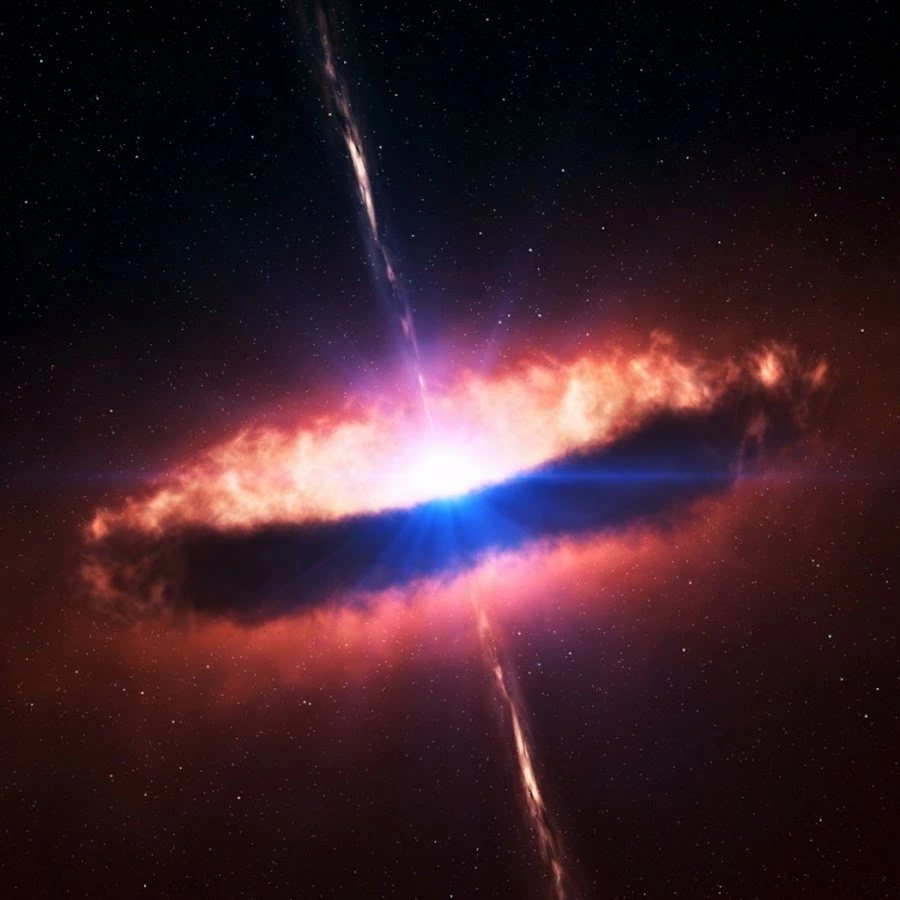Is it at all possible that instead of being pushed away, we are instead getting pulled toward something huuuuuge via gravity? As if we are falling into something way greater than ourselves? I thought this was a wild idea but after I Googled it I found out that there is such a thing as a “Great Attractor”. Something 150 million light-years away is literally pulling all nearby galaxies towards it but no one knows exactly what it is.
So how do we know there aren’t any other Great Attractors, Greater Attractors, ad infinitum?
I think you need to let go of this idea that the big bang happened at a specific location or that we are moving away from or towards a point in space. There is no specific point from which all points in space are departing. Instead, every point in space is moving away from every other.
Consider the following!
Point at any object. That object is at some distance away from you in space which is also a distance away from you in time. For example, an object one light year away is one year into the past, as perceived by you.
Now, point in any direction. No matter where you point, if you extend the line forever, it intersects with the big bang. There is no place to which you can point, no direction, no infinite line you can draw that doesn’t include the big bang.
Now I’m even more confused 😄
The explanation was probably fine, I just can’t wrap my head around it
The big bang wasn’t inside the universe to push anything. The big bang was the universe.
Think of it like leaves on a puddle. As water(space/dark energy) flows into the puddle. It expands. The leaves don’t. They just spread out over the surface of the puddle unless they are bound together with other leaves via surface tension(gravity).
I saw a really good demonstration of this once, but I can’t seem to find a video of it.
Basically imagine a rubber tube with 4 balls equal distance apart from each other.
–0–0–0–0–
If you stretch the tube from both ends all of the balls move an equal distance apart.
----0----0----0----0----
There is no one ball that is the center or the starting point. However if you focus on one ball while stretching it will seem like the others are moving away from it. But in reality they are all moving away from each other at the same rate.
And as far as we know, the tube is a loop or infinite, so it doesn’t even have a center itself.
That’s a excellent picture
A lot of people describe the first moment of the big bang as infinitely small, dense, and hot. These descriptions may approximate that first moment of existence, but they slightly miss the mark because in the very first moment of existence, size, density, and temperature didn’t exist. There was nothing to compare anything else against.
Instead, let’s visualize that moment as infinitely same. Erase all thoughts of violent explosions happening very quickly and instead just imagine a single point of light. Not big, because size requires multiple things. Not small because it encompasses everything. Just one infinite same.
Now, since it’s hard for us to visualize change in an infinite void that is simultaneously nothing and everything, imagine that point of light as a magical tank engine at the front of a never-ending train. And our job as conductors of that train is to get to the caboose at the end.
The train cars could theoretically go in any order, but because we conductors are beings of time who need them to arrive on a schedule, we must visit each car in a precise order. And before we can access a car, we must make it unique by showing it something that has never been seen before.
For the first car, this is easy. We simply show it the tank engine at the front of the train. So, the inside of the first car transforms its interior into a copy of the tank engine it’s attached to.
But when we arrive at the second car, things are more complicated. The cars have already seen the tank engine. So, instead, we show the second car the first car. And the second car transforms into a copy of the first car and the tank engine attached to that. And inside the copy of the first car is another copy of the tank engine.
As you can imagine, the further down we get on this train, the more this starts to get out of hand. Copies of copies of copies abound. The magic train is powerful, but as mortal conductors of time, we worry our own powers may have limits. So, to reduce the burden on ourselves, we take some shortcuts. Instead of trying to visualize increasingly long nested copies of trains inside each new car we visit, we start to conceptualize these copies as amounts, or amplitudes. When we open the door to a new car, all of the amplitudes inside resonate and interact, becoming maybe more abstract than they are in reality. They form spatial dimensions and physical properties, as mediated by fundamental forces.
These aren’t set in stone, but determined by the lens through which we view them. And when we look through specific lenses, we see these forces causing certain repeated amplitudes to intermingle and stabilize to the point that even though all of the train copies are further nested when we step into the next car, we can recognize and identify some of the same structures, just shifted slightly in their spatial relationships since we last witnessed them in the previous car. We call these persistent formations matter. And as their shared spatial relationships cause them to cluster and coalesce, we refer to that as gravity.
While in the early cars, this continuum of space and matter is not impossible to conceptualize, the more cars we travel through, the more apparent it becomes that these increasingly complex objects are becoming more and more isolated from each other. At every scale of amplitude, each nested car is attached to its own tank engine. While these engines can interact with each other virtually, at the end of the day, they are all just virtual copies of the train we are on. It is entirely impossible for any one of these tank engines to travel so far that it reaches the edge of its bounding box. Because that bounding box is just a lens through which we imagine overlapping traits of increasingly many very similar objects. And the more of them we imagine, the more space is required to provide the virtual framework of this lens.
So, when we feel like we are experiencing random events in our small subsection of the universe, those events are not truly random, but instead the result of our precise position in the the universal train we’ve been virtually sliding through for over 13 billion years. The universe has become so large that it contains every possible event that could have happened in this span of time. The events are not random but calculated, and duplicated every moment so that every time we enter a new train car, two copies of our observable universe exist at a distance so far apart it’s impossible to comprehend.
And when we observe celestial objects apparently propelled away from each other at increasing speed, they are not really being pushed or pulled anywhere. It is simply an artifact of trying to keep track of the “same” object in rapidly advancing train cars, while each car doubles in size to contain everything the previous car had, as well as everything new that might emerge from the duplication event. The celestial objects year by year, and indeed ourselves from moment to moment, are never the same thing twice. It’s an illusion brought forth by our brains being born into a cosmic flipbook.
Even something as simple as seeing multicolored pixels on this screen is not real, but the result of virtual “tank engines” moving into the same spatial zones occupied by our retinas, which are themselves constructed of virtual trains of varying size. The reason photons move at a set maximum speed which makes them exempt from experiencing time is because they are all just virtual copies of the real locomotive which is driving the whole train. Every photon in our universe is just a make-believe copy of the very first moment of the big bang. A specter of infinite sameness.
So, objects in our universe aren’t moving apart as much as the space between them is increasing to account for the overhead of a universe with constantly growing entropy and uniqueness. The extra space represents a boundary which limits how far light can travel and affect matter in its realm of influence. If you’re still reading this, somewhere out there, in a part of our universe so far away that light from our known universe will never even remotely reach, there is an opposite you made of antimatter reading the exact same thing as written by an opposite me. But we are only made of matter because of a virtual compression of sameness, so that antiverse may be the exact place where the curvature of the entire universe loops back around and is overlaid upon itself. And the uncertainty of photons may arise from the fact that there are two identical universes overlapped and constantly exchanging probabilities. And this may be the compressive property which allows the fundamental forces to exist in the first place. So, say hi to yourself. You’re the reason you’re here.
Im saving this to read again later. Is this your own analogy?
Yeah. Been trying to find a non-boring way to visualize the start of the universe for a long time. Most of the time I reach for binary which in retrospect is way less fun than trains 🚂
Fantastic! I am going to read this many times. Well written, and smart choices.
Here’s another way to think about the location of the big bang.
If we look at the night sky, between the planets and stars, into the darkness we find there’s a faint glow emanating from everywhere. This is the cosmic microwave background, the oldest electromagnetic radiation that has taken the longest possible time to reach us because by this construction you avoided all the other objects in the way. This extends your view of the past to its maximum value: the age of the universe, which is literally all of the available time for photons to travel. Note that this is a simplification because it makes some assumptions about the transparency of the early universe, but it suits us fine.
It’s coming from everywhere because all of those places were there at the big bang. Where was the big bang? It was over there. And also in the opposite direction, there. Because all of those places were here.
Like, popping into existence all at once? Like a 3 dimensional blanket just popping in already moving as it is?
Try this:
So everything in space, every object had to get to where it is via time. It travelled there. Everything can’t be anywhere without time as without time it wouldn’t have been able to move there. Time is a constant graph, and as it moves forward, things move around and as such, space is able to exist. This is why we consider space and time to be linked.
Now consider this: if one was to plot a graph of space and time on an x y axis to track an object, there is a point on the graph where time has to be zero, and as such space has to be zero.
This is the big bang.
It is the beginning of the graph. When time was zero, and as such so was space.
Space did not burst out from a single point that we could find out there in space, as there was no point. everything was still everywhere much like it is now, except everywhere just so happened to be so close to one another to be at the same point on the graph. When time began, it just about instantly expanded out, everywhere in every direction. There is no ‘center’ to this expansion, just like if you blow up a balloon there is no center on the surface of the balloon, it just expands everywhere, and more importantly with time we are able to quantify this.
I think this is hard to visualize with words like “out” being used, because then there must be an “in”, and if you draw everything back “in” you get a Centerpoint, no matter what.
Same with the baloon, because when plated, its going in all directions except for “in”, and in space, objects are zooming past each other, “in” and “out” yet still as expansion movement. (Right? I only kind of understand what you’re explaining while guessing at why it’s not 100% understandable for me.
In fact, anything that expands with a surface is going to be hard to visualize as how space moves because it all has a point it starts from.
Literally no idea if I’m making sense here.
Think of a balloon. Squish the deflated balloon as where everything was. All of it started at a similar point but then the balloon started expanding and everything is moving away at an accelerated pace from each other
The balloon analogy can lead one astray. Our minds see the middle of the balloon inside and think “Big Bang was there”. But the analogy is only for the surface, and the Big Bang included all the surface, and nothing else.
deleted by creator
I like this one :)
When you look far away, you’re looking backwards in time. If you look really far away, you look really far back in time. If you look far enough away, you’ll see the big bang.
If you move a thousand light years to your left and do this again, you still see the big bang. Even though your “center” has changed. The big bang is more like a singularity in time than it is in space
We found Bill Nye’s Lemmy account!
deleted by creator
Well, if the sphere was there all along, yes, it’s possible. Very unlikely, but possible. If the whole universe is moving somewhere, we have no way to detect it. Note that this doesn’t exclude the Big Bang, that still happened even in your scenario.
It’s just one of those unprovable things - like whether there’s a God or whether we live in a Matrix. Unprovable and thus irrelevant.
From my layman’s perspective after having watched probably every space documentary produced for channels like the Space channel and Discovery’s conglomeration, the big bang happened and propelled matter out from the source but now, billions of years later, space is expanding not only from this source but also between everything that was propelled from this initial blast.
If you likened that to the USA, the big bang happened in central Iowa, but things aren’t just expanding from the source in Iowa, cities like LA and San Fran are also expanding away from each other at an accellerated rate. AFAIK, the leading theory is that dark matter is causing the intra-galaxy expansion, but little is known about dark matter and what drives this expansion. This is why it is believed that the universe will die a cold death (where all solar energy burns out) rather than collapsing in on itself since everything is moving away from everything else. At a certain point of expansion, nothing will have a gravitational effect on anything else.
It is dark energy, and not dark matter, that is believed to be causing the accelerating expansion of the universe. Dark matter has the opposite effect - gravitational attraction.
No, the big bang happened everywhere, not just in a single point. The PBS documentaries will tell you as much.
Everything not gravitationally bound is moving away from everything else. Every single point in space is growing larger. That means that things farther away from you are moving away from you faster then things closer to you. That’s true no matter where in the universe you are.
There’s not really an “away” from the big bang. That’s something science communicators fail to explain - the big bang happened everywhere. Space may have been infinite in size (we don’t know) and it still happened everywhere.
I’d recommend looking up the YouTube channel for FermiLab. They’ve got some excellent videos on the subject.
Also everyone always forgets to mention the “not gravitationally bound” part, so kudos for that.
So I’m getting bigger? How much per year?
No. Local attractive forces, like gravity, especially those at the atomic level, overpower the expansion for tightly coupled systems. So the earth isn’t expanding, and neither are the people on it. I don’t recall exactly what scale it kicks in at, but there is a good chance it’s not even affecting the distance between planets in a system. Most likely it only plays a role in inter-planetary-systems and larger. Ie, stars get further apart from each other.
Edit. This explains it better https://www.astronomy.com/science/does-the-space-inside-an-atom-expand-with-the-universe/
That says that the expansion really only applies to the space between galaxies. In anything smaller than that, gravity still overpowers the expensive forces. Making it far weaker than I initially thought.
It’s at a much, much larger scale** than that — our local group is collapsing in on itself, and it’s ~10M lightyears in diameter.
** talking about length scales only makes sense in reference to the specifics — two bananas separated by 10M lightyears, with no other matter nearby, would (I’m guessing) be expanded away, but a cluster of galaxies will not.
Using a banana for scale really made this so much better. :)
Yeah, finally I can imagine the vastness of space. Thank you, bananas!
Wouldn’t it cause some sort of force locally at the atomic level all the same even for tightly coupled systems? They shouldn’t feel the expansion as it is not a force from my understanding but just growth of space itself. But for example wouldn’t the orbit around an atom be off just so slightly that it would need to expend some level of energy to correct for lack of better word.
Or do we think this does happen but the amount is so small that we can not measure it experimentally in any way.
My understanding is that it does exert a force everywhere, even locally. It’s just so incredibly weak that other local forces dominate and overpower it. Take the classic example of expansion as ants on a balloon as it’s inflated. The expansion wants to pull them apart, but if they were tied to each other by thread, the thread would be stronger and they would stay together. The thread represents the inter molecular forces. Also remember that the expansion force is in every direction, without an origin, so from an atom’s perspective the force seems to push outward,not from the side, so there would be no “offset”.
I don’t know about you but I definitely am. Not sure the big bang is too blame, but I like that excuse.
The forces that hold your body together are many, many orders of magnitude stronger than the acceleration due to the expansion of space.
Check your waistline to find out.
Thank you so much for the explanation!
I’m going to sound like a total idiot but if our universe was at the center of a ginormous sphere could that give an illusion that every point in space was moving away from another when in fact we could all be falling (getting pulled by gravity) toward whatever edge of the sphere we are closest to?
Kind of a tangent at this point, but there is a very good reason that that couldn’t be the case: according to the shell theorem , nowhere in the interior of a spherical shell of matter experiences any net gravitational force – wherever you are inside the sphere, the forces counteract exactly.
Otherwise, though, the metric expansion of space is different from typical movement, and it isn’t correct to say that things or being pushed or pulled. Rather, the distance between every pair of points in the universe increases over time, with that rate of increase proportional to the points’ distance. Importantly, for very distant points, the distance can increse faster than the speed of light, which would be disallowed by any model which describes the expansion in terms of objects moving in a traditional sense.
You are right that things would still look like we’re accelerating away from us, even if we were actually contracting.
Interesting hypothesis! How do we investigate?
What could we expect from a large central gravitational point? We should have other signs of the gravity well:
We would expect a point that we contract towards (and that seems ill fitting, as we see the expansion moves as the observer (including earth) moves), we would expect some kind of mass or similar effect, which would also have a size to fit it in (we know that gravity works different when you’re inside the mass, and we would be able to see it, much like black holes or dark matter), we would expect things to orbit the gravity well (which we know that at least our galaxy doesn’t orbit us).
You might want to actually check on these things to make sure they apply and are true, but at least at first glance it seems the expansion is better explained without a central gravity.
The Universe probably wouldn’t fit in a sphere of any size and it very well may be infinite.
But looking at a very large spherical region like the visible universe from our perspective here on Earth, everything is moving away from us. If objects were being pulled towards one particular edge of our imaginary sphere, it would look very different. We’d see a clear drift in that direction, but it all looks pretty even across every direction we look.
Not unless we were directly in the center of it, in which case everything would seem to move away from us. But even then, if I’m not mistaken, physicists and astronomers have also proven that other objects are also moving away from one another too.
We can tell how something is moving based on the shift of its light, like the Doppler effect. The further something is the more its light is shifted, which was how we came to know this phenomenon in general of increasing size of space between all things.
other objects are also moving away from one another too
What if everything is just getting smaller and smaller, so it just appears that everything is getting further away from everything else? Eventually, everything will be really tiny, but we won’t notice, because everything else will be the same smol also.
Lol if joking. If not, I’m sorry but you severely misunderstood what is happening here
Totally just joking. But I like to play with ideas, even absurd ones. So partly not joking also?
We know what the great attractor is, pop-sci tiktoks just pretend we don’t know to make it seem mysterious.
https://www.universetoday.com/113150/what-is-the-great-attractor/
If you want to know more about what we really know about the universe, make sure to follow the right sources. Universe Today is a great read for the most up to date info on space.
unfortunately, it’s on the other side of the Milky Way, so we can’t see it.
The thing that blows my mind is that, Gigantosaurus could (have; but Plesiosaurs couldn’t). This more than any other fact illustrates the enormous time span of the dinosaurs’ rule.
We are closer to the extinction of the T-Rex than the T-Rex was to the extinction of the stegosaurus.
This more than any other fact illustrates the enormous time span of the dinosaurs’ rule.
You do know that only some of the dinosaurs died and one large lineage is still alive, right?
The structures of our observable universe are larger than you might think.
If you’re truly interested in jumping into the rabbit’s black hole.
Gravity bends light. You can literally detect large masses by how they distort the space around them. From what we can observe, space overall is pretty flat. AND we can measure where stuff is going using various proxies i.e the doppler shift, spectral lines, standard candles etc. If stuff was being pulled toward some mass, its going to cause deviations in how fast things are moving relative to each other. Which in the case of the great attractor, is what is happening. But if you are asking whether everything is falling toward something in every direction equally, the answer is no due to the shell theorm.
space overall is pretty flat
What do you mean by that?
Look at a piece of paper. Mark two points on it that are a good distance apart. Travel can only happen along the surface of the paper. When it’s flat, your time of travel depends on the distance between the two points on that paper.
Now dap a spot of glue next to one of the points and fold the paper in such a way that the other point comes to rest close to that glue. Wait for it to bind and then spread the paper a little without breaking the glue. That glued point is a wormhole, a place where two points of that flat 2D universe touch despite not being next to each other. Travel from point A to point B is now a shorter distance thanks to the wormhole. But there is no way in which the paper universe can be described as flat anymore.
Or think of a papermache ball, that’s also made from paper but if you travel long enough in one direction, you’ll end up where you started. Because it isn’t flat.
Now our universe is 3D not 2D, but from a higher dimensional perspective it has the same prooerties of flatness as that 2D paper has for us.
Geometrically speaking, if you draw a really, really big triangle between, say three galaxies, the angles of the triangle add to 180° in a flat universe. In a non-flat space, this would not be the case. For example, if you draw a triangle between, say, New York, Berlin and Rio de Janeiro on the surface of the Earth, the three angles between the lines would add to more than 180° since Earth is topologically a sphere and not flat. And if you draw three lines beween three points on a saddle shape like a Pringles chip, you’ll find that the angles add up to less than 180°.
Fun fact: topologically speaking, no matter how you fold or bend a sheet of paper, it remains flat. A cilinder is a flat surface with zero curvature!
What I mean is that what we observe is best approximated as a relative lack of spatial curvature over long distance scales. One of the lines of evidence for this is the cosmic microwave background. A flat topology for space-time over long distances would look different than an open or closed universe: https://phys.org/news/2017-06-universe-flat-topology.html
When I talk about my Big Bang Theory fan page it propels women away.

Others have mentioned, everything is moving away from each other, like the surface of an expanding balloon. But that is what we observe, and there is more beyond the observable universe.
There is an idea that our universe might actually be in a black hole in a higher universe. To expand on the balloon simile (pun intended), this would be like a balloon expanding uniformly except in a spot, a bubble appears and expands faster. A bubble within a bubble. Kind of a tumor, an outgrowth universe. Hope I’ve been illustrative enough.
It’s not exactly what you asked, but a higher level black hole is kind of something pulling all matter in our universe instead of pushing.














